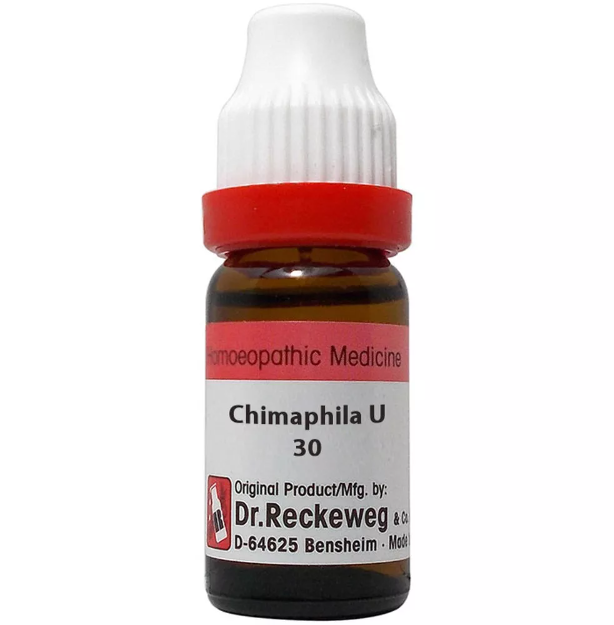CHIMAPHILA UMBELLATA Q, 6C, 12C, 30C, 200C, 1M, 10M USES AND SYMPTOMS
 CHIMAPHILA UMBELLATA
CHIMAPHILA UMBELLATA
(Pipsissewa)
Chim.
Primarily affects the kidneys and genito-urinary tract, as well as lymphatic and mesenteric glands and the female breasts. Suitable for young women with dysuria and those with large breasts. Effective for hepatic and renal dropsies, chronic alcoholism, and early-stage cataracts.
Useful for bladder issues, particularly acute and chronic cystitis, with symptoms of scanty urine containing ropy, muco-purulent sediment. Helps with prostatic enlargement.
Head: Pain in the left frontal area, halos around lights, itchy eyelids, stabbing pain in the left eye with tearing.
Mouth: Toothache worsens after eating and exertion, relieved by cool water. Pain feels like gentle pulling.
Urinary: Frequent urge to urinate. Turbid, offensive urine with ropy or bloody mucus, depositing heavy sediment. Burning and straining during and after urination. Scanty urine, acute prostatitis, retention, sensation of a ball in the perineum. Fluttering near the kidneys. Diabetes. Requires standing with feet apart and body inclined forward to urinate.
Male: Smarting in the urethra, from the bladder neck to the meatus. Gleet, loss of prostatic fluid, prostatic enlargement and irritation.
Female: Inflamed, swollen labia, vaginal pain, hot flushes. Painful, non-ulcerated mammary tumors with excessive milk secretion, rapid breast atrophy. Women with large breasts and sharp pain in mammary gland tumors.
Extremities: Sensation of a band above the left knee.
Skin: Scrofulous ulcers, glandular enlargements.
Modalities: Worse in damp weather, from sitting on cold surfaces, and on the left side.
Relationship: Compare with Chimaphila maculata (intense hunger, burning fever, swelling sensation in armpits), Uva, Led., Epig.
Dose: Tincture to third attenuation.
SYMPTOMS OF CHIMAPHILA UMBELLATA
Head:
Pain in the left frontal area
Halos around lights
Itchy eyelids
Stabbing pain in the left eye with tearing
Mouth:
Toothache worsens after eating and exertion, relieved by cool water
Pain feels like gentle pulling
Urinary:
Frequent urge to urinate
Turbid, offensive urine with ropy or bloody mucus, depositing heavy sediment
Burning and straining during and after urination
Scanty urine
Acute prostatitis, retention
Sensation of a ball in the perineum
Fluttering near the kidneys
Presence of sugar in urine (diabetes)
Requires standing with feet apart and body inclined forward to urinate
Male:
Smarting in the urethra from the bladder neck to the meatus
Gleet
Loss of prostatic fluid
Prostatic enlargement and irritation
Female:
Inflamed, swollen labia
Vaginal pain
Hot flushes
Painful, non-ulcerated mammary tumors with excessive milk secretion
Rapid breast atrophy
Large breasts with sharp pain in mammary gland tumors
Extremities:
Sensation of a band above the left knee
Skin:
Scrofulous ulcers
Glandular enlargements
Modalities:
Symptoms worsen in damp weather, from sitting on cold surfaces, and on the left side
selection of the potency
Individualization:
- Homeopathy is based on the principle of treating the individual, not just the disease. The unique symptoms and characteristics of the person are crucial in determining the most suitable potency.
Intensity of Symptoms:
- The intensity of the symptoms guides the choice of potency. If the symptoms are intense and acute, a lower potency (e.g., 6C, 30C) might be considered. For chronic conditions with less intensity, higher potencies (e.g., 200C, 1M) may be appropriate.
Sensitivity of the Patient:
- Some individuals are more sensitive to homeopathic remedies, while others may require higher potencies. The practitioner considers the patient’s sensitivity when selecting the potency.
Acute vs. Chronic Conditions:
- Lower potencies are often used for acute conditions, while higher potencies may be considered for chronic or long-standing issues.
Previous Response to Potencies:
- The patient’s response to previous homeopathic treatments helps guide the choice of potency. If a particular potency has been effective in the past, it may be repeated or adjusted as needed.
Vital Force and Susceptibility:
- Homeopathy views illness as a disturbance in the vital force. The practitioner assesses the patient’s overall vitality and susceptibility to determine the appropriate potency.
Aggravation or Amelioration:
- The direction of the symptom response (aggravation or amelioration) after taking a remedy can influence the choice of potency.
Miasmatic Considerations:
- In classical homeopathy, the concept of miasms (inherited disease tendencies) is considered. The practitioner take this into account when selecting the potency.
Practitioner Experience:
- The experience and preference of the homeopathic practitioner play a role. Some practitioners may have success with certain potencies based on their clinical experience.
SAFETY INFORMATION
- Do not exceed the recommended dose by physician
- Keep out of the reach of children
- Store in a cool dry place away from direct sunlight
- Maintain half an hour gap between food/drink/any other medicines and homoeopathic medicine
- Avoid any strong smell in the mouth while taking medicine e.g. camphor, garlic, onion, coffee, hing
Medicine images use for reference only selection of homeopathic medicine depends on the individual’s specific symptoms and overall constitution. Moreover, homeopathy is a holistic system of medicine that treats the individual as a whole. In addition to addressing the physical symptoms, it takes into account the emotional and mental state of the person. Consequently, it’s crucial to consult with a qualified homeopathic practitioner for personalized treatment.
The information provided on this website is intended solely for educational purposes. Always seek the advice of your physician or other qualified health provider.
